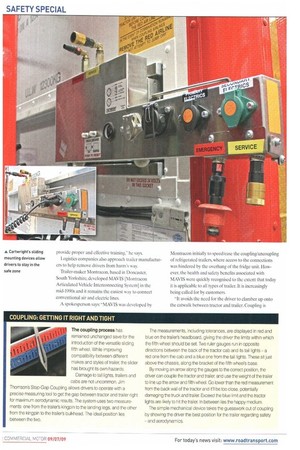COUPLING: GETTING IT RIGHT AND TIGHT
Page 42

If you've noticed an error in this article please click here to report it so we can fix it.
The coupling process has remained unchanged save for the introduction of the versatile sliding fifth wheel. While improving compatibility between different makes and styles of trailer, the slider has brought its own hazards.
Damage to tad lights, trailers and cabs are not uncommon. aril Thomson's Stop-Gap Coupling allows drivers to operate with a precise measuring tool to get the gap between tractor and trailer right for maximum aerodynamic results. The system uses two measurements: one from the trailer's kingpin to the lancing legs, and the other from the kingpin to the trailer's bulkhead. The ideal position lies between the two. The measurements, including tolerances, are displayed in red and blue on the trailer's headboard, giving the driver the limits within which the fifth wheel should be set. Two ruler gauges run in opposite directions between the back of the tractor cab and its tail lights a red one from the cab and a blue one from the tail lights. These sit just above the chassis, along the bracket of the fifth wheel's base, By moving an arrow along the gauges to the correct position, the driver can couple the tractor and trailer, and use the weight of the trailer to line up the arrow and fifth wheel, Go lower than the red measurement from the back wall of the tractor and it'll be too close, potentially damaging the truck and trailer. Exceed the blue limit and the tractor lights are likely to hit the trailer. In between lies the happy medium.
The simple mechanical device takes the guesswork out of coupling by showing the driver the best position for the trailer regarding safety and aerodynamics.












































































































































